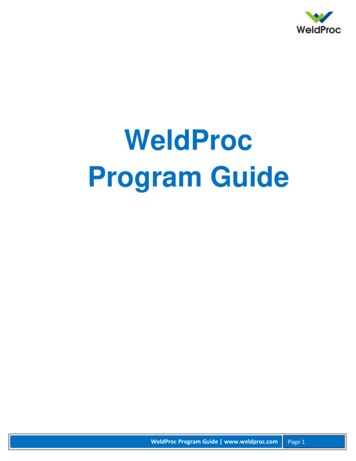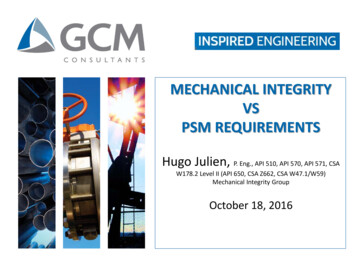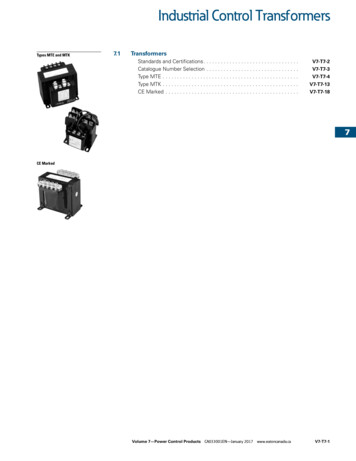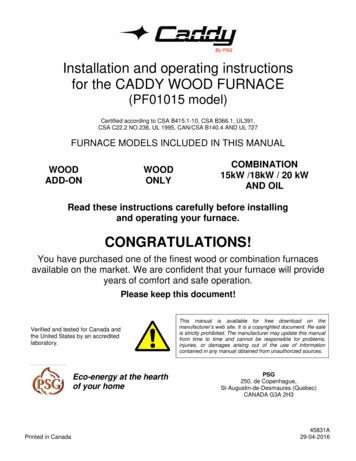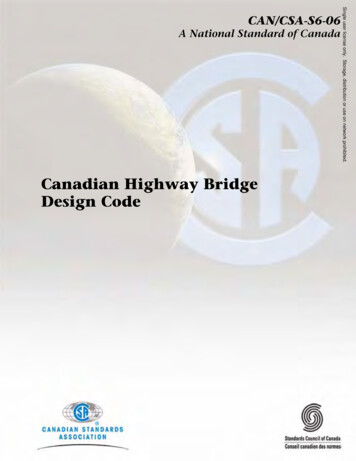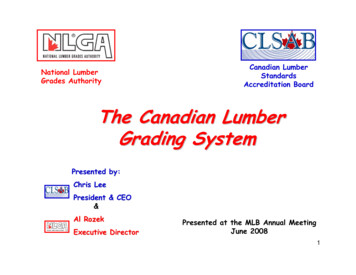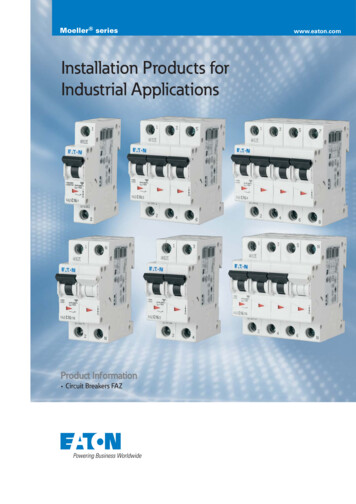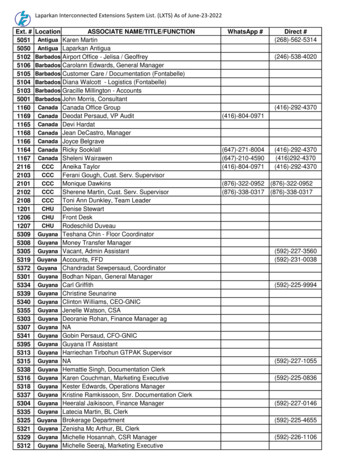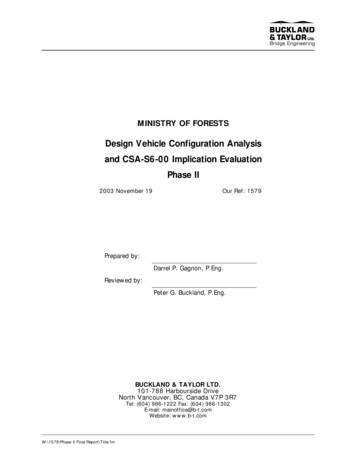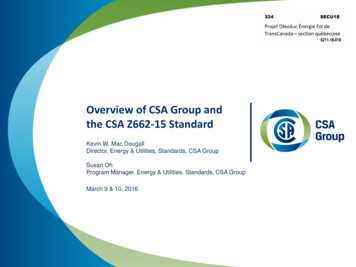
Transcription
Overview of CSA Group andthe CSA Z662-15 StandardKevin W. Mac DougallDirector, Energy & Utilities, Standards, CSA GroupSusan OhProgram Manager, Energy & Utilities, Standards, CSA GroupMarch 9 & 10, 2016
Agenda Introduction of CSA Group and the standarddevelopment process Overview of CSA Z662 Highlight of key changes in the 2015 Edition of CSAZ662 Additional Information2
Introduction of CSA Group andthe Standards Development Process
Overview of CSA GroupKey Facts Established in 1919 Global leader in standards development, producttesting and certification, and product evaluation– 38 offices in 15 countriesSingapore4
Overview of CSA GroupCSA Standards Independent, not-for-profit membership association Serves business, industry, government, and consumers Accredited by Standards Council of Canada Develops standards designed to:––––enhance public safety and healthadvance the quality of lifehelp to protect the environmentfacilitate trade5
Overview of CSA GroupBreadth of CSA StandardsManagement Systems Quality Management and Auditing, RiskManagementConstruction and Infrastructure Building Products and Systems,Components & Structures, Masonry &Steel, PlumbingElectrical Installation and Safety Codes, Productsand Components, Distribution andGeneration , Engineering , ElectroMagnetic CompatibilityEnergy Petroleum & Natural Gas IndustrySystems, Gas & Fuel Burning Equipment Alternative Energy Vehicles, EnergyEfficiency, Renewable Energy NuclearEnvironment Environmental Performance andManagement, Life Cycle Analysis and Product LabellingHealth Care and Medical Devices Facilities Engineering, Patient Care andSafety, Infection Control, Sterilization andDevice Reprocessing, Blood and Tissue,Medical Labs, NanotechnologiesWorker and Workplace Safety Ergonomics, Electrical Safety, ManagementSystems, Equipment & Machine Safety, FallProtection, Personal Protective EquipmentTechnical Safety Pressure Vessels, Elevators and LiftingDevices, TransportationPublic and Community Safety Injury Protection, Accessibility, EmergencyPreparedness6
Overview of CSA GroupStandards Development Methodology CSA members develop standards content; stafffacilitates the accredited development process Once published, standards are continually reviewed,revised and refreshed CSA standards are voluntary documents Only when referenced by government or a regulatoryauthority is their compliance mandatory7
Overview of CSA GroupStandards Development ProcessProjectProposalAssign toCommitteeNotice ofofIntentIntentMeetings/DraftPublic notificationPublicPublicReviewReviewTC reachesconsensusTechnicalApproval (vote)PublicationPublic notificationMaintenanceMaintenanceDuring this stage the public can: submit suggestions for change request an interpretation of a requirementPublic notification8
Overview of CSA Z662
CSA Z662CSA Z662 – Oil and gas pipeline systems Z662 contains 500 pages of prescriptive and performancebased technical requirements Z662 takes a lifecycle approach; itcovers the design, construction,operation and maintenance ofpipelines, along with requirementsfor safety management systems CSA standards are continuallyreviewed and updated to incorporatelessons learned, technologicaladvancements and best practices10
CSA Z662CSA Z662 Technical Committee Over 250 expert volunteer committeemembers The Technical Committee (TC) operatesunder consensus with a balancedcommittee matrix The TC is supported by 10 TechnicalSubcommittees (TSCs) with variousworking groups under each of theseTSCs TC and TSC representatives participateinternationally at ISO TC67/SC211
CSA Z662CSA Z662 ScopeThis Standard covers the design, construction, operation, andmaintenance of oil and gas industry pipeline systems that conveya) liquid hydrocarbons, includingcrude oil, multiphase fluids,condensate, liquid petroleumproducts, natural gas liquids,and liquefied petroleum gas;b) oilfield water;c) oilfield steam;d) carbon dioxide used in oilfieldenhanced recovery schemes; ore) gas.12
CSA Z662Standard Content - 17 Clauses and 14 Annexes:Clause 1:ScopeClause 2:References and DefinitionsClause 3:Safety and Loss Management SystemsClause 4:DesignClause 5:MaterialsClause 6:InstallationClause 7:JoiningClause 8:Pressure TestingClause 9:Corrosion ControlClause 10:Operating, maintenance, and upgradingClause 11:Offshore steel pipelinesClause 12:Gas Distribution SystemsClause 13:Reinforced composite, thermoplastic-lined, and polyethylene pipelinesClause 14:Oilfield steam distribution pipelines13
CSA Z662Standard Content - 17 Clauses and 14 Annexes:Clause 15:Aluminum pipingClause 16:Sour service pipelinesClause 17:Composite-reinforced steel pipelinesAnnex A:Safety and Loss Management SystemAnnex B:Guidelines for risk assessment of pipelinesAnnex C:Limit states designAnnex D:Guidelines for in-line inspection of piping for corrosion imperfectionsAnnex E:Recommended practice for liquid hydrocarbon pipeline system leakdetectionAnnex F:Slurry pipeline systems (deleted in 2015 edition)Annex G:Precautions to avoid explosions of gas-air mixtures (deleted in 2015edition)Annex H:Pipeline failure records14
CSA Z662Standard Content - 17 Clauses and 14 Annexes:Annex I:Oilfield steam distribution pipelines — Alternate provisionsAnnex J:Recommended practice for determining the acceptability ofimperfections in fusion welds using engineering critical assessmentAnnex K:Standards of acceptability for circumferential pipe butt welds basedupon fracture mechanics principlesAnnex L:Alternative or supplementary test methods for coating property andcharacteristics evaluationAnnex M:Guidance for system control, monitoring, and protection of liquidpipelinesAnnex N:Guidelines for pipeline system integrity management programsAnnex O:Reliability-based design and assessment (RBDA) of onshore non-sourservice natural gas transmission pipelinesAnnex P:(New) Development and qualification and welding procedurespecifications15
CSA Z662Standard Application Z662 is referenced by oil and gas pipeline and facilityregulators, including:– National Energy Board (for pipelines crossing provincial orinternational borders), and– Ontario, British Columbia, Alberta, Saskatchewan, Manitoba,Quebec, New Brunswick and Nova Scotia The timing of regulatory adoption following publication variesbetween regulators Regulators may choose to reference Z662 as published orwith modifications through regulations16
Highlight of key changes in the2015 Edition of CSA Z662
Key Changes to 2015 editionUpdated requirements for safety and loss management systems,integrity management programs, and engineering assessments process.(Clause 3 and Annex A)Description:The update clarify the requirements for safety and loss management systemby expanding the use of integrity management programs and engineeringassessments for oil and gas industry pipeline systems. These requirements,combined with the recommended practices in Annex A, are intended toenhance the protection of people, the environment, and property.18
Key Changes to 2015 editionClarification of requirements for mitigation programs for internalcorrosion and monitoring of the effectiveness of the programs whenpipelines are susceptible to internal corrosion (Clause 9)Description:The revised requirement highlights the proactive approach for consideringthe risk of corrosion unless there is proof that corrosion would not occur.These requirements are applicable to the operation, maintenance, andupgrading of existing installations. This revision is intended to reduce riskand improve reliability.19
Key Changes to 2015 editionNew requirements for training and certification of field applied coatingapplicators through a reference to CSA Z245.30 (Clause 9)Description:The application company shall ensure that all personnel involved inassisting the applicators are trained in the specific tasks that have beenassigned to them (e.g., surface preparation, preheat, and mixing) prior tothe start of work.20
Key Changes to 2015 editionExpanded scope to further recognize CO2 pipeline systemsDescription:The revised scope was expanded to include deactivation andabandonment of oil and gas industry pipeline systems that convey liquid ordense phase carbon dioxide, and vapour phase carbon dioxide.The broadened scope to include carbon dioxide pipeline systemsaddresses the use of pipelines to transport carbon dioxide for manypurposes, not only for enhanced recovery schemes, but also fortransportation over long distances of captured carbon dioxide for storageor sequestration.21
Other Key Changes to 2015 edition Further requirements for abandonment of pipelines (Clause 10) New requirements for addressing ripples and wrinkles, buckles, and outof roundness on pipe (Clause 10) Clarification of the requirements for reinforced composite, thermoplasticlined, and polyethylene pipelines Clarification of the sour service requirements for gas-free pipelinesystems for crude oil, crude oil blends, and low vapour pressurecondensate (Clause 16) Updating of the requirements for leak detection on liquid hydrocarbonpipelines previously published in Update 3 (August 2013) to CSA Z66211. The recommended practice considers computational methods anddirect leak detection methods (Annex E) Expansion of Annex M to address system control, monitoring, andprotection for all hydrocarbon pipelines New Annex P to provide guidance on the development and qualificationof welding procedure specifications22
Supporting CSA StandardsSecurity Management (CSA Z246.1) Specifies criteria for establishing a security management program toensure security threats and associated risks are identified and managethrough mitigation and response processes and proceduresEmergency Preparedness and Response (CSA Z246.2) Provides requirements for developing an emergency preparedness andresponse program to provide greater safety for workers, establish bestpractices that are consistent across Canada, and help protect people,property and the environmentDamage Prevention (CSA Z247) Aims to address the challenges facing damage prevention in Canada;identifying the damage prevention process and outlining its keyelements that when consistently applied, can reduce damage tounderground infrastructure and enhance public safety23
Emergency Preparedness and Response (CSA Z246.2) Provides requirements for developing an emergency preparedness and response program to provide greater safety for workers, establish best practices that are consistent across Canada, and help protect people, property and the environment Damage Prevention (CSA Z247)
